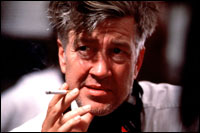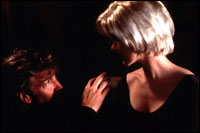They are served by a waitress
called Betty who was previously called Diane. Diane also sees
the young neurotic man terrified of the tramp in the primary
dream narrative. The diner, we see, is still haunted by the
monstrous tramp. We encounter “him” the back of the diner at
night. The tramp has possession of the blue box “he” first plays
with then hides away in a paper bag. We see tiny hobgoblin figures
of the same old couple of her jitterbugging days and Hollywood
welcome in the dream narrative crawl out from the blue box.
Although she becomes a murderer, Diane’s decline is depicted
as searingly tragic. Utterly alone in her tawdry apartment,
the rejected lover and failed actress is persecuted by the cackling
hobgoblins who crawl out from under the door. Transforming into
normal, human size, screaming like maniacs, they chase the young
woman around her room. In madness and despair, Diane takes her
own life. To Angelo Badalamenti’s gorgeous romantic score, Mulholland
ends with the nightsky of Hollywood invaded by the hallucinogenic
blurs of Betty and Camilla, happy and enamoured. The final word,
however, goes to the same cadaverous woman with the bizarre
blue hair from the club : “Silencio”.
| |
 |
|
|
Diane is corrupted, dehumanised and discarded
by the dream factory. Ideologically bound to the Hollywood
dream, she is easily seduced by the system. As Betty tells
Rita in the dream narrative, “I just came from Deep River
Ontario and now I’m in this dream place”. Lynch’s characterisation
of Betty/Diane is dark and ambiguous. Thus, Mulholland
Drive cannot be understood as a straight, feminist
polemic (Excuse the pun). Betty is revealed as a narcissist.
Lynch’s portrayal of the actress seems to conform to Freud’s
description of the narcissistic woman. For Freud, women are
in general more inclined to narcissism than men. In On
Narcissism (1913) :
“Women, especially if they grow up with good looks, develop
a certain self-contentment... Some women have the greatest
fascination for men, not only for aesthetic reasons... but
also because of a certain combination of interesting psychological
factors... The charm of a child lies to a great extent in
his narcissism, his self-contentment and his accessibility,
just as does the charm of certain animals which seem not to
concern themselves about us, such as cats and large beasts
of prey. Indeed great criminals and humorists, as they are
represented in literature, compel our interest by the narcissistic
consistency with which they manage to keep away from their
ego anything that would diminish it. It is as if we envied
them for maintaining a blissful state of mind - an unassailable
libidinal position which we ourselves have abandoned.”
(7)
 |
|
|
|
Betty’s unreal, sunny disposition and over-reaching
self-consciousness from the outset barely mask a primary narcissist.
She even seeks to disguise Rita as herself, telling her, “I
know what you have to do... Let me do it.” She has Hollywood
diva pretensions : “Of course I’d rather been known
as a great actress than a movie star but some people end up
being both”. While Betty is portrayed as an absolute personification
of female narcissism, Lynch also arguably portrays Diane as
a phallic being. Ultimately, Diane is a murderess. Murder
provides her with the ultimate means of preserving her ego
- and sanity of course. Diane is also a sexually aggressive
lesbian. Thus, Lynch could therefore be said to replay phallocentric,
psychoanalytical Hollywood images of women which represent
women as pathological and regressive and which bind women
to mythic transgression and evil. More ambiguously, more dangerously,
within the narrative of the auditioning screenplay, Lynch
represents Betty’s character as simultaneously repelled and
turned on by her father’s friend. She tells him to “Get
out” as she kisses him ravenously. Equally, the characterisation
of Camilla could also be said to be masculinist and negative.
The Camilla of Diane’s reality is no longer the yielding lost
lover Rita but a cool, detached femme fatale lover of Diane’s
reality who cruelly taunts her with displays of hetero and
homosexual desire with other partners. Harring plays Camilla
as the glamorous, disinterested Hollywood whore. As a promiscuous,
feline goddess, Camilla is also a true narcissist. Thus, Lynch’s
Hollywood spawns beautiful and degenerate female demons.
|